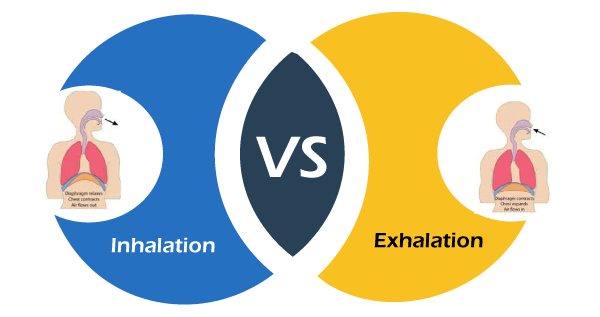Difference between Inhalation and ExhalationBreathing is a simple process, yet people are not able to do that. The regulation of breath is very important for the body to stay strong against everything. Now, how do we regulate breath? Well, breath can be regulated through a simple yogic practice called pranayama. Simply, concentrating on the inhalation and exhalation of breath leads to tremendous health benefits. Shortness of breath is a common disorder experienced by people. Doing pranayama every day can help in getting rid of it. Pranayama, along with other kinds of yoga, helps in stabilizing the body. So today, we are going to discuss the differences between exhalation and inhalation. But before looking upon the differences, let us discuss in brief about the meanings of these terms. 
InhalationInhalation is defined as the process of taking in air and other substances into our lungs. The air, along with other gases, enters our body through inhalation. The process of inhalation takes place through the nose and mouth. Deep breathing is very essential for the human body. It makes the diaphragm strong, thereby resulting in good functioning of the lungs. As we know, COVID-19 is a respiratory disease; therefore, we must do our breathing practices on a daily basis to strengthen our lungs. Breathing generally does not need any conscious control or effort, but it is advised to do breathing exercises. Inhalation enables oxygen to enter our body, reaching the organs and absorbing itself into the bloodstream. Well, there are some substances that accidentally enter our system. For instance, inhalation of water can be caused due to drowning, smoke, bad food, and various other substances that can enter our body through the process of inhalation. Apart from that, people also take some substances deliberately through inhalation, like drugs, helium, nitrous oxide, etc. These substances can prove to be fatal for the body. Some substances are used for medications, but the substances that are deliberately consumed by people (drugs) must be stopped. Inhalation means to 'breathe in,' i.e., the body intends to take in the clean air into the lungs. But sometimes, smoke and other substances enter our body which might lead to certain infections. ExhalationExhalation is defined as the process wherein the air moves out from the lungs through the airways in the body. The volume of air is decreased in the body leading to an increase in the pressure upon the body. When the pressure increases, the air tends to rush out from the body. Exhalation is a passive process in which muscle contraction does not take place. Exhalation takes place for one simple reason, i.e., getting rid of the carbon dioxide from the body. After inhalation, the body undertakes the exchange of oxygen in pulmonary capillaries. This process leads to the removal of CO2 and other substances from the body. The process of exhalation is longer than inhalation. Along with carbon dioxide, substances like methanol, ketones, water, and other hydrocarbons are also moved out from the body. The brain controls the exhalation process. This process can be broken into two segments, i.e., voluntary and involuntary control. In voluntary exhalation, the air is held and released at a fixed rate. Examples of voluntary exhalation include exercising, singing, playing some instrument, etc. Involuntary exhalation takes place through respiratory organs in the body. Metabolic and behavioral breathing is often termed as involuntary exhalation. Now, there are certain points of difference between inhalation and exhalation. So, let us discus them.
So, these are some of the contrasting points between inhalation and exhalation. These breathing processes are essential for the sustenance of the human body. One must try to regulate their breathing through yoga practices. According to B.K Iyengar, both inhalation and exhalation must be done through the nose. He emphasizes on the fact that exhalation must not be done through the mouth. Breathing must only be done through the nose. Pranayama is necessary for regulating the breath. Thus, inhalation and exhalation are significant processes in the human body.
Next TopicDifference between
|
 For Videos Join Our Youtube Channel: Join Now
For Videos Join Our Youtube Channel: Join Now
Feedback
- Send your Feedback to [email protected]
Help Others, Please Share










